When your company is beginning to think about expanding your brand overseas, you’ll need to consider how to structure your website or websites in order to maximize your online presence overseas as well. One of the most important considerations when building new multilingual or multi-country websites is how to optimize your international website(s) for SEO.
Google Webmaster Tools outlines the pros and cons of four different ways to structure your website(s) to target multiple languages or multiple languages. These are:
- ccTLDs (“country-coded top-level domains”)
- gTLDs (“generic top-level domains”) with sub-domains
- gTLDs with sub-folders
- URL parameters
This documentation is helpful but not thorough enough to be comforting. There are some pros and cons that are noticeably missing in Google's chart, such as any mention of how domain authority is handled for different types of site structures. So which one really is the best approach?
A much more comprehensive pros and cons discussion of each international site structure is in order. By the end of this article, you will have a much better grasp of the options available for scaling your website(s) appropriately to maximize the return on investment for international SEO.
A Test of Accuracy for International Site Structures
One of the main goals when setting up international sites is making sure that the right users find the right version of your site. International SEO done right means that your users in each target country or targeted language are coming to the proper country or language page of your site. So, I measured the percentage of accuracy for each type of site structure (ccTLD, sub-domain, or sub-folder). I did not evaluate URL parameters, since that structure is not generally recommended. My hypothesis was that ccTLDs are in general, the best at geo-targeting with the highest percentage of accuracy, followed by sub-folders and then lastly by sub-domains. But I wanted to test this empirically.
First, I evaluated ccTLDs. I looked at three brands that use separate, country-coded top-level domains to target their international audiences. This is easy to do using Semrush's Domain Overview Report. Simply type in the name of a domain, and then select the relevant country's search engine. For example, for tripadvisor.co.uk, you would select UK Google as the search engine.
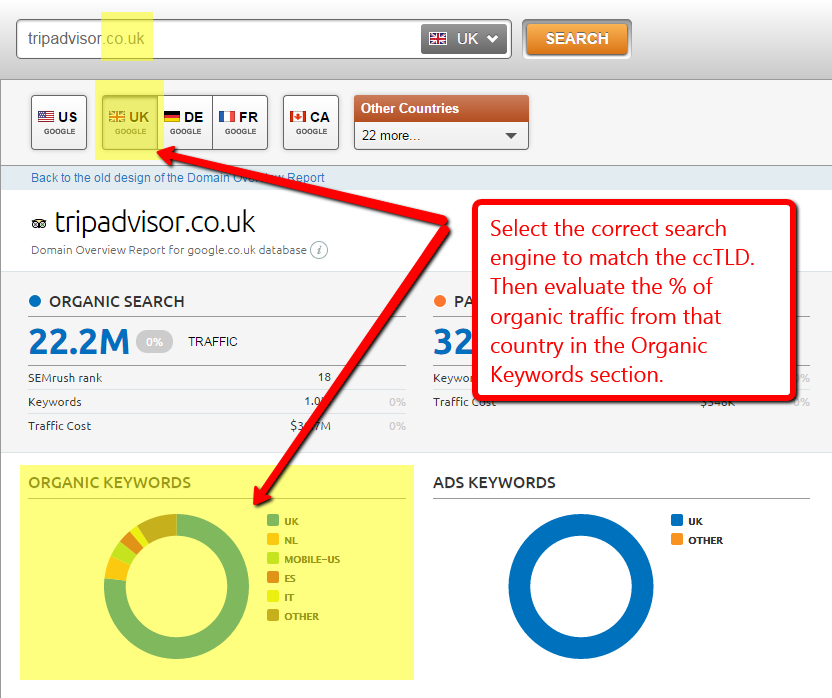
Then, hover over the doughnut chart in the Organic Keywords section to see the percentage of keywords that are ranking for that country. For tripadvisor.co.uk, when you hover over the UK (blue) section, currently has 76.86% of keywords ranking in the UK.
After doing this for multiple ccTLDs for three brands, I found the following results:
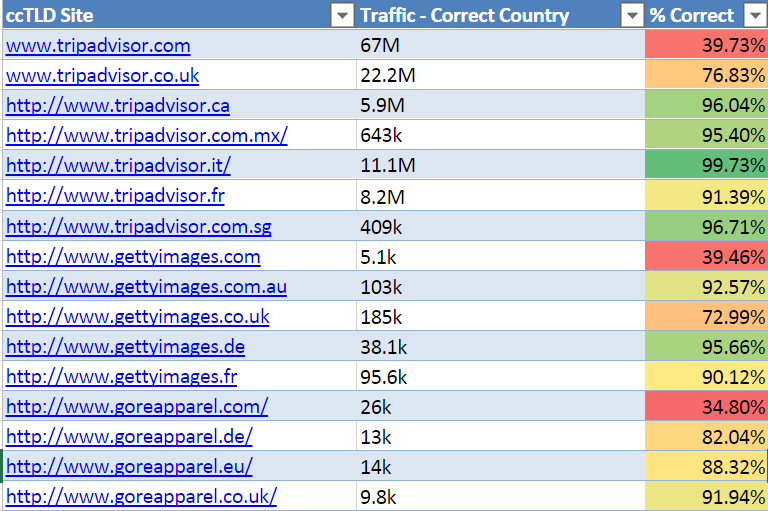
This chart records the organic traffic from each site, as reported by Semrush, as well as the percentage of organic keywords that are ranking in the correct country. As you can see from this chart, except for the US*, most sites have above 90% accuracy.
*It is important to note that .com is a generic top-level domain, and if geo-targeting in Webmaster Tools is not set to a specific country and if hreflang is not targeting a specific country, then .com will generally act as the catch-all for all other countries. It is also perceived as the most “global” of all domains, which is in part why The Guardian famously migrated their domain from theguardian.co.uk to theguardian.com in 2014.
Now, in order to get similar data for sub-folders and sub-domains, you need to view data from within Google Analytics or similar analytics platform. I will explain how to pull the data from Google Analytics here.
For Sub-Folders (or Sub-Directories)
To find what percentage of users from the correct country or languages are viewing the correct pages of your site, use the Content Drilldown report. Set the Advanced Segment to Organic, so that you can view only the top organic landing pages. This makes it easy to view metrics based on all pages within high-level sub-folders. You can also set the primary dimension to a Content Grouping, if you need to customize the way your geo-targeted sub-folders appear in Google Analytics.
Then, add Country as a secondary dimension. Here is the report generated for a SaaS solutions company, who has sub-folders targeting the Americas, Australia and New Zealand, Africa, Europe, and the rest of the world under “Saas Solutions:”
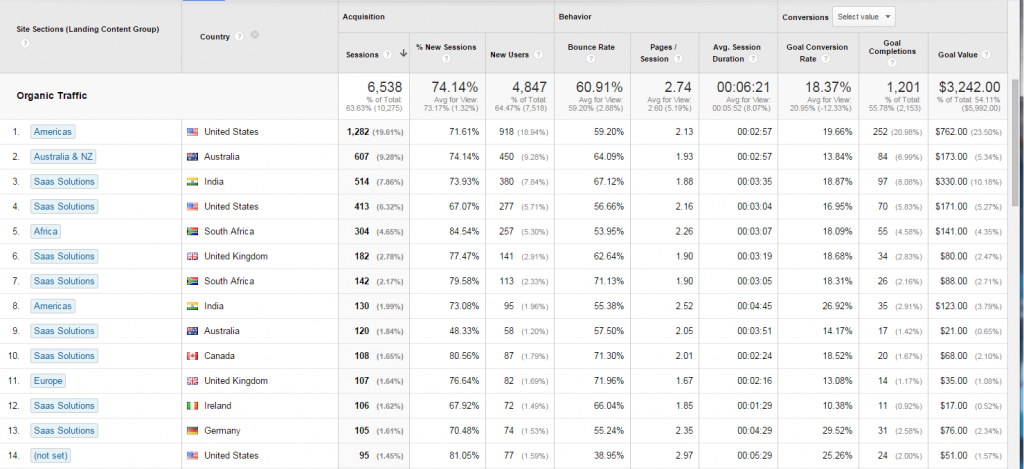
As you can see, there are some categories where users from the correct country are not going to the correct part of the site. Note that this company had grouped together whole regions within Content Groups, but were actually only targeting one country per region using hreflang. So actually, we should only expect a high degree of accuracy for the country that hreflang is targeting (not the whole region). Here's the breakdown of what each region was actually targeting:
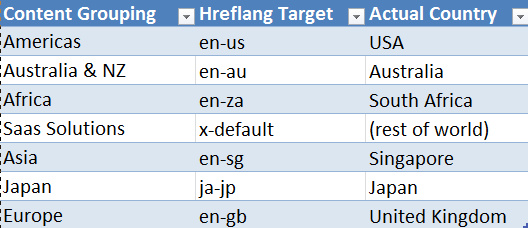
It's important to remember that hreflang can only target on a country or a language level, not on a regional level.
Here are the results for this company's geo-targeting, along with the results for two other brands that were either country or (in the case with the cannabis company) language targeting:
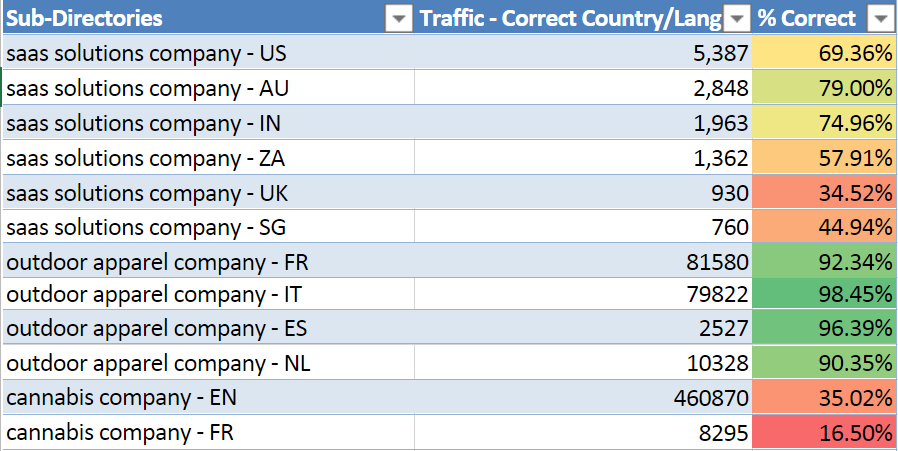
As you can see from this chart, the numbers are a lot lower on average than ccTLDs, except for the outdoor apparel company's averages. In that case, the company used a .eu ccTLD to target the European Union, with sub-folders for each individual country. This allowed them to eliminate the need for separate top-level domains for each country, but still target only the EU rather than use a generic top-level domain. This strategy has been very effective for them.
Sub-domains
For sub-domains, you need to have a roll-up reporting view configured in Google Analytics, and then add hostnames as the primary dimension to the Content Drilldown Report. Make sure you're segmenting by only organic traffic. Then you can add Country as the secondary dimension. Here's an example of what the report will look like:
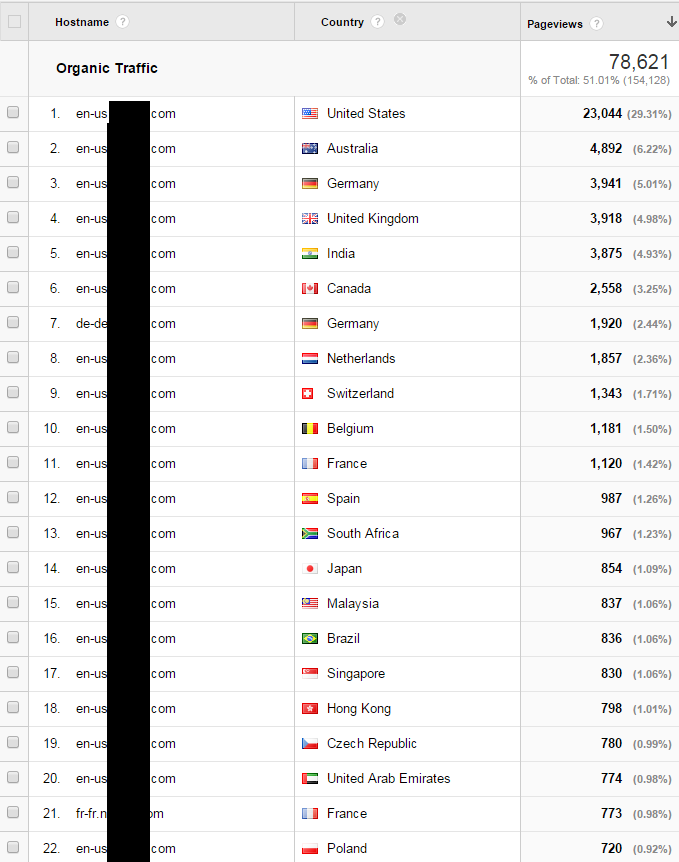
Viewing this data can help you see whether visitors are coming to the right version of your site or are ending up in the wrong place. Here are the results for two companies that use sub-domains for geo-targeting. Note that one company uses their “www” sub-domain to target the UK and x-default with hreflang (which is not best practice).
 Besides one exception with the home décor company's sub-domain in Australia, where accuracy is 93.18%, all others are below 90%.
Besides one exception with the home décor company's sub-domain in Australia, where accuracy is 93.18%, all others are below 90%.
Tallying up the averages for ccTLDs, sub-folders, and sub-domains from these charts, we find these results:

This chart confirms my hypothesis that ccTLDs have the highest degree of accuracy, followed by sub-directories and next sub-domains. However, it should be noted that my sample size was small (only 8 brands and 30 sites in total), and there are other factors such as different hreflang implementations that are skewing the accuracy rates. I also do not have access to all these domain’s Webmaster Tools to see whether geo-targeting is also a factor. However, this does seem to confirm a trend that I’ve noticed and I hope others will add to this data set.
So Which Site Structure is Best?
Even though ccTLDs have the highest degree of accuracy, this is not necessarily the best approach for all brands. There are significant costs involved with ccTLDs. Instead, I’d like to propose the following pros and cons chart, and then explain in what scenarios ccTLDs are appropriate:
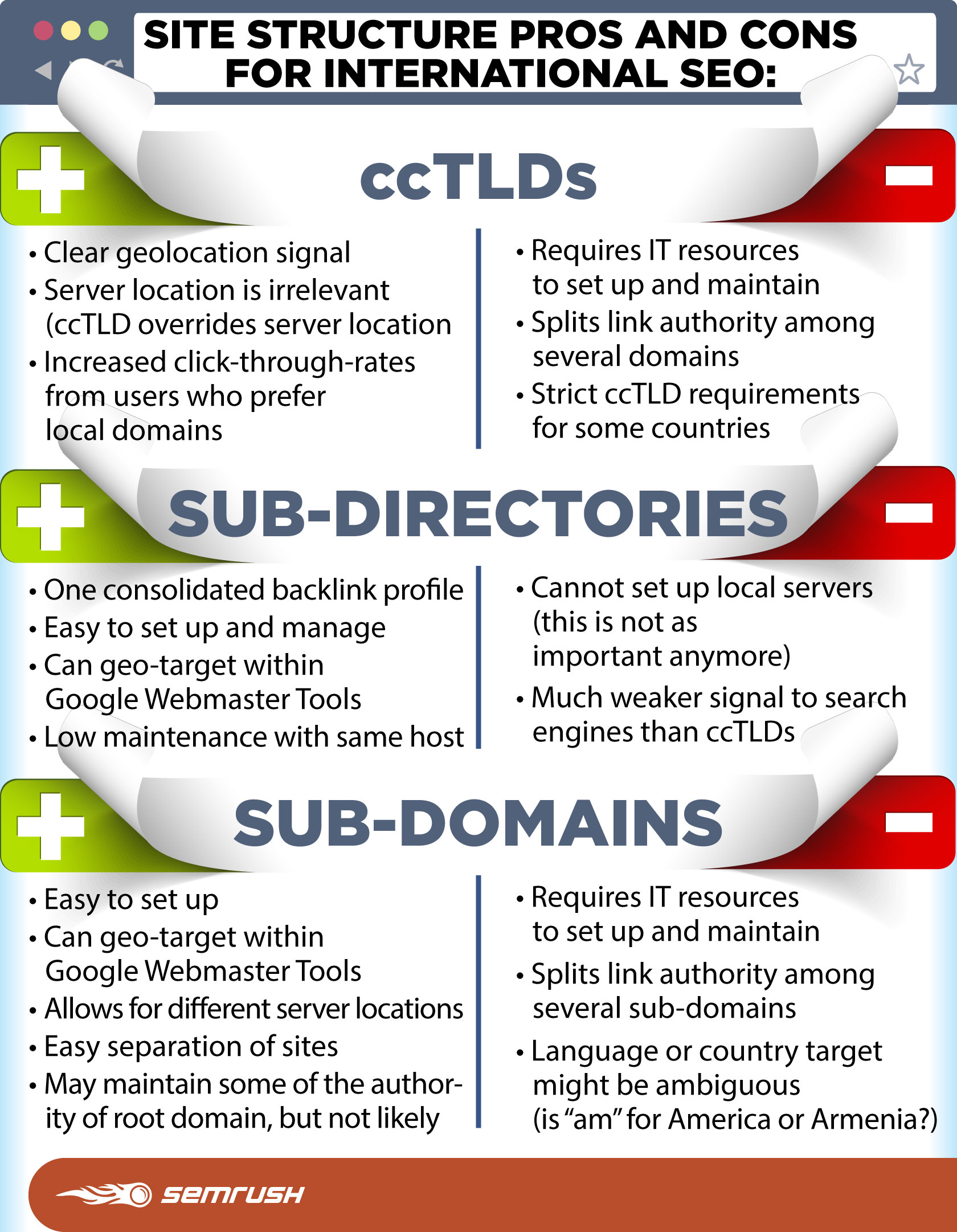
ccTLDs are Best For
This option requires significant investment upfront, but can be the right choice for larger brands, such as internationally-known brand names that already have a presence in international markets. Companies should choose this structure if they have:
- Significantly large audiences in each of their target countries
- Development and design resources to build and maintain multiple sites, customized for regional audiences
- Resources to develop unique, localized content written by professional translators in the local language
- Resources for investing in regional link outreach
- Significantly different product catalogs or services for each region
- Are a retail or ecommerce brand that wants to target by countries
- Offices in the target countries
Sub-Directories are Best For
This option is the best for most companies who do not have a global household brand name and do not have a high volume of content or resources to maintain multiple sites. It’s especially good for a well-established website with a high domain authority that is looking to expand into new international markets.
The benefits of geo-targeting signals that come with ccTLDs are generally far outweighed by the loss of link authority split among new top-level domains. It takes concentrated effort to build a healthy backlink profile for one site, so it is likewise difficult to build healthy backlink profiles for ccTLDs. Sub-directories offer the singular advantage of a consolidated backlink profile. Companies should choose this option if they:
- Want to keep maintenance costs to a minimum
- Do not have the resources to build and maintain multiple sites
- Do not have the resources for investing in regional link outreach
- Do not have significantly different product catalogs or services for each region
Sub-Domains are Best For
This option is best for companies with a desire to keep their brand name in main domain, but who need separate international sites for internal business reasons. There are typically not enough advantages over ccTLDs or sub-folders to make sub-domains a good option.
Conclusion
Planning the site structure for your international SEO campaign is one of the most crucial steps. ccTLDs are great for brands with a big budget, but for smaller companies, sub-folders are a viable option, and can be used effectively in tandem with hreflang and localization. Make sure that you evaluate the pros and cons in relation to your business, and decide which site structure makes the most sense given your company’s amount of resources and budget.
